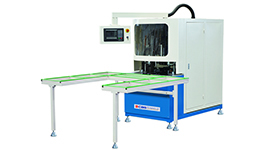Aluminium machine
Cutting MachineMilling MachinePunching and Drilling MachineCorner Crimping EquipmentProfile Bending MachineThermal Break Aluminum Profile LineMachining CenterAluminium Formwork Machine
Aluminium Formwork Cutting MachineAluminium Formwork Punching MachineAluminium Formwork Lacquering MachineSlot Milling MachineMiscellaneousFriction Stir Welding MachineAutomatic Multi-processing Aluminium Machinery
Hinge Making MachineSolar Panel Clamps/Cleats Making MachineAluminium Hardware Making MahcineOther Automatic MachinesuPVC window machine
Cutting MachineMilling MachineWelding MachineCorner Cleaning MachineBending MachineAuxiliary Machine
upvc windows and doors corner cleaning machine is used for cleaning the welding seams of upvc windows and doors, it's a necessary equipment for aluminium and upvc windows and doors manufacturing.
After uPVC/pvc/plastic profiles are heated, melted and welded to form the window frames, which have welding seams at the corners. Cleaning these welding seams with a corner cleaning machine not only enhance the beautiful appearance of PVC-u, pvc, plastic windows and doors, also ensure weld strength and increase the productivity of the upvc/pvc windows and doors.
CBS Industry Co Ltd only manufacturing high quality corner cleaning with up-to-date technology, from manual corner cleaning machine, common corner cleaning machine to CNC corner cleaning machinery, and automatic CNC corner cleaning line for bulk upvc windows and doors production also.
After uPVC/pvc/plastic profiles are heated, melted and welded to form the window frames, which have welding seams at the corners. Cleaning these welding seams with a corner cleaning machine not only enhance the beautiful appearance of PVC-u, pvc, plastic windows and doors, also ensure weld strength and increase the productivity of the upvc/pvc windows and doors.
CBS Industry Co Ltd only manufacturing high quality corner cleaning with up-to-date technology, from manual corner cleaning machine, common corner cleaning machine to CNC corner cleaning machinery, and automatic CNC corner cleaning line for bulk upvc windows and doors production also.

